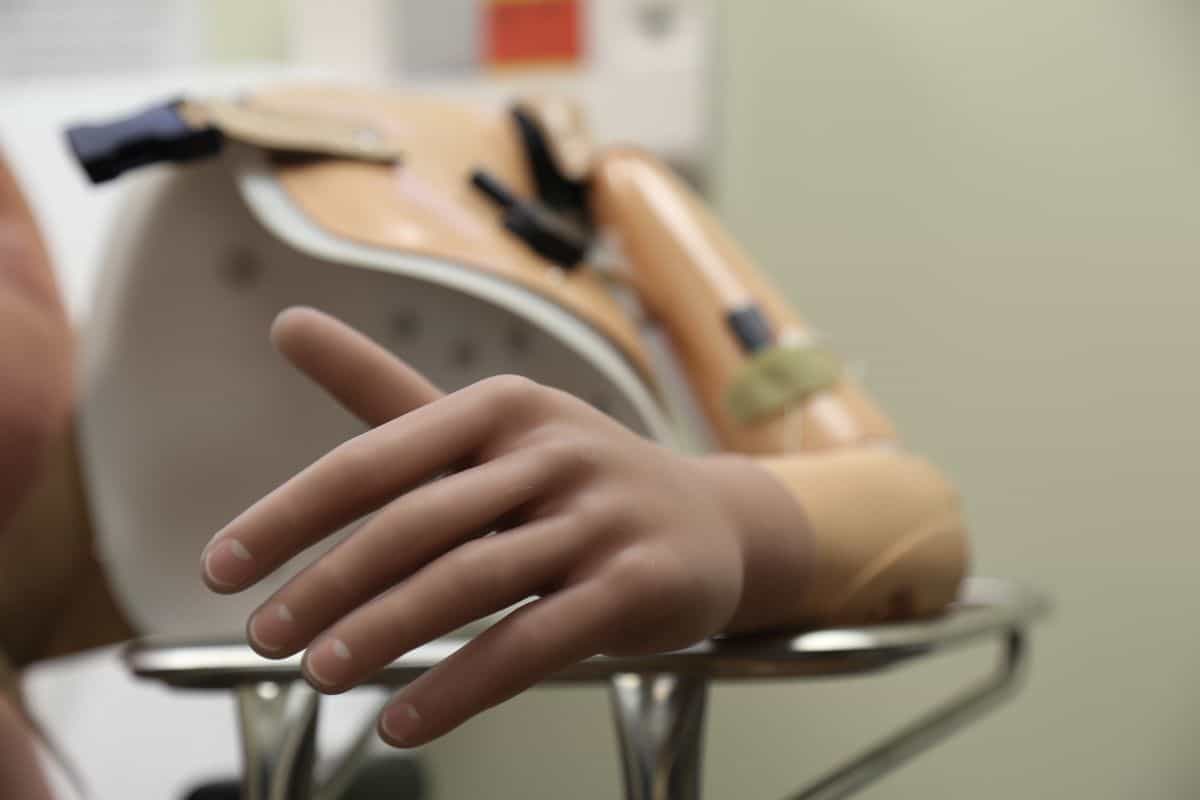View Larger Image

UAMS' Autumn Road Orthopaedics Clinic is dedicating a day each month to see patients with upper extremity amputations. Patients can see a doctor, occupational therapist and prosthetist in one visit.
Image by Katrina Dupins
Orthopaedics Dedicates One-Stop Clinic for Upper Extremity Amputees
| Patients with amputations to their fingers, hands and arms can receive care from a specialized physician, occupational therapist and prosthetist all under one roof at the University of Arkansas for Medical Sciences (UAMS) Autumn Road Orthopaedics Clinic.
Once a month, this multidisciplinary team will focus on upper extremity amputations so patients can be seen by a doctor, have their needs assessed by an occupational therapist, and be fitted for a wide range of the latest available prosthetics, streamlining their need to make multiple trips.
Fellowship-trained upper extremity surgeons Mark Tait, M.D., and John W. Bracey, M.D., are part of the team, along with occupational therapist Angela Green and an upper extremity prosthetist who will fly in from out of state. Together, they will provide a level of upper extremity care unique in Arkansas.

Mark Tait, M.D., left, and John W. Bracey, M.D., are part of the team, along with occupational therapist Angela Green and an upper extremity prosthetist who flies in from out of state.
“Our aim is to make it easier for patients to receive follow-up care after amputation surgery,” Tait said. “We want to see that they’re healing, but we also want to see that they know all their options going forward so that they can live their best life.”
Bracey agreed and added, “Our patients come from across the state and surrounding states, so we want to help them make the most of their time.”
The clinic is for anyone with an upper limb amputation, including: multiple fingers, partial hand, full hand, below the elbow, above the elbow and into the shoulder. The amputation could be recent or several years or decades in the past.
The occupational therapist will assess the patient’s needs and provide referrals for any necessary follow-up therapy close to the patient’s hometown.
The prosthetist will provide information on a range of options that might be best suited for the patient’s goals. These include myoelectric-controlled prostheses, which allow the wearer to control the prosthetic device by using muscle contractions in the residual arm, and body-powered prostheses, which function by using movements elsewhere in the body to allow the patient to extend the arm or grasp an object, for example.
For more information, visit Go.UAMS.edu/AutumnRoad or call 501-526-1046.
UAMS is the state’s only health sciences university, with colleges of Medicine, Nursing, Pharmacy, Health Professions and Public Health; a graduate school; a hospital; a main campus in Little Rock; a Northwest Arkansas regional campus in Fayetteville; a statewide network of regional campuses; and eight institutes: the Winthrop P. Rockefeller Cancer Institute, Jackson T. Stephens Spine & Neurosciences Institute, Harvey & Bernice Jones Eye Institute, Psychiatric Research Institute, Donald W. Reynolds Institute on Aging, Translational Research Institute, Institute for Digital Health & Innovation and the Institute for Community Health Innovation. UAMS includes UAMS Health, a statewide health system that encompasses all of UAMS’ clinical enterprise. UAMS is the only adult Level 1 trauma center in the state. UAMS has 3,485 students, 915 medical residents and fellows, and seven dental residents. It is the state’s largest public employer with more than 11,000 employees, including 1,200 physicians who provide care to patients at UAMS, its regional campuses, Arkansas Children’s, the VA Medical Center and Baptist Health. Visit www.uams.edu or uamshealth.com. Find us on Facebook, X (formerly Twitter), YouTube or Instagram.###